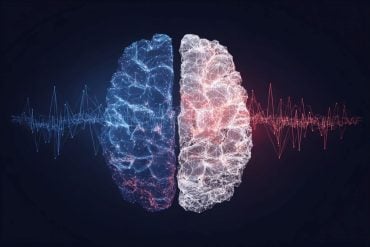Summry: New research reveals that dopamine plays a crucial role in teaching young male mice to fight, with the chemical’s influence diminishing as they gain experience. In novice fighters, boosting dopamine increased aggression, while blocking it stopped them from fighting.
However, experienced fighters showed no changes in behavior regardless of dopamine manipulation, highlighting the role of experience in shaping aggression. The study identifies the lateral septum as a key brain region for “aggression learning” in males, but no similar effect was observed in females.
Key Facts:
- Dopamine’s Role: Dopamine promotes aggression in novice male mice but becomes less influential with experience.
- Brain Region Identified: The lateral septum mediates dopamine’s effects on aggression learning in males.
- Gender Differences: Dopamine manipulation did not impact aggressive behaviors in female mice.
Source: NYU Langone
Like humans, mice will compete over territory and mates, and show increased confidence in their fighting skills the more they win. At first, a brain chemical called dopamine is essential for young males to master this behavior. But as they gain experience, the chemical grows less important in promoting aggression, a new study shows.
Dopamine has been linked to male aggression for decades. How past experiences might influence this relationship, however, had until now been unclear.

In experiments in rodents, a team led by researchers at NYU Langone Health boosted activity in dopamine-releasing cells in a part of the brain called the ventral tegmental area.
The findings revealed that in inexperienced male fighters, this led the animals to attack for twice as long as they would have fought naturally. When the cells were blocked, the novice mice would not fight at all.
By contrast, this pattern did not hold true in males that had extensive fighting experience. Whether or not dopamine-releasing cells were boosted or blocked, the duration of attack did not change. Notably, though, the more clashes a mouse won, the more fights it would start in the future.
“Our findings offer new insight into how both ‘nature’ and ‘nurture’ shape aggression in males,” said study senior author Dayu Lin, PhD.
“While aggression is an innate behavior, dopamine — and fighting experience — is essential for its maturation during adulthood,” added Lin, a professor in the Departments of Psychiatry and of Neuroscience at NYU Grossman School of Medicine.
A report on the findings is publishing online Jan. 22 in the journal Nature.
Building on their evidence for the role of dopamine in learning aggression, authors set out to better understand the brain mechanisms that might explain it. To do this, the team prevented cells in the ventral tegmental area of the brain from releasing dopamine into another region called the lateral septum, a site known to regulate aggression.
They found that novice males would never learn to fight, but those with previous fighting experience would continue to engage in aggressive behavior. Similarly, promoting dopamine release in this area of the brain boosted hostility in rookies but had no effect on veterans.
This suggests that the lateral septum is a key brain site for dopamine to promote “aggression learning” in rodents and likely in other mammals, including people, says Lin, who is also a member of NYU Grossman School of Medicine’s Institute for Translational Neuroscience.
The team also measured dopamine release in the lateral septum as the animals gained fighting experience. They found that the chemical surges the most on the day they first decide to attack.
As the mouse becomes more experienced with fighting, this dopamine spike becomes less dramatic, supporting a central role of the chemical in initial aggression learning.
Importantly, the researchers also found that dopamine did not appear to play a similar role in female aggression. In fact, manipulating dopamine levels did not affect aggressive behaviors in female mice in any way.
According to Lin, the results may offer new insight into addressing mental health conditions marked by intense shifts in mood and behavior, such as schizophrenia, bipolar disorder, and borderline personality disorder.
Antipsychotic drugs that interfere with dopamine release are commonly used to treat such diseases, as well as to suppress violent behavior in psychiatric patients.
“Our results suggest that targeting dopamine may not be an effective tool when treating those with a long history of aggression,” said Lin.
“As a result, healthcare providers may need to consider a patient’s history, as well as their age and sex, when considering which therapy to use.”
Lin adds that the results may also explain why antipsychotic drugs are known to have a stronger and longer-lasting effect in children than in adults, for whom aggression often returns once they stop receiving medication.
That said, Lin cautions that while mice share similar brain chemistry with people and that the current findings echo human clinical results, more research will be needed to demonstrate the impact of past behavior on the effectiveness of antipsychotic medications in humans.
Funding: Funding for the study was provided by National Institutes of Health grants R01MH101377, R01MH124927, U19NS107616, U01NS11335, U01NS12082, P30DA048736, and R01MH133669. Further study funding was provided by the Vulnerable Brain Project.
In addition to Lin, other NYU Langone researchers involved in the study are Bingqin Zheng, MS; Xiuzhi Dai; Xiaoyang Cui, BS; Luping Yin, PhD; Jing Cai, PhD; and Nicolas Tritsch, PhD.
Other study investigators include Yizhou Zhuo, PhD, and Yulong Li, PhD, at the Peking University School of Life Sciences in Beijing; and Larry Zweifel, PhD, at the University of Washington in Seattle. Bing Dai, PhD, a former graduate student at NYU Langone and a current postdoctoral associate at the Massachusetts Institute of Technology in Cambridge, served as the study lead author.
About this aggression and neuroscience research news
Author: Shira Polan
Source: NYU Langone
Contact: Shira Polan – NYU Langone
Image: The image is credited to Neuroscience News
Original Research: Closed access.
“Experience-dependent dopamine modulation of male aggression” by Dayu Lin et al. Nature
Abstract
Experience-dependent dopamine modulation of male aggression
Numerous studies support the role of dopamine in modulating aggression, but the exact neural mechanisms remain elusive. Here we show that dopaminergic cells in the ventral tegmental area (VTA) can bidirectionally modulate aggression in male mice in an experience-dependent manner.
Although VTA dopaminergic cells strongly influence aggression in novice aggressors, they become ineffective in expert aggressors. Furthermore, eliminating dopamine synthesis in the VTA prevents the emergence of aggression in naive mice but leaves aggression intact in expert aggressors. VTA dopamine modulates aggression through the dorsal lateral septum (dLS), a region known for aggression control.
Dopamine enables the flow of information from the hippocampus to the dLS by weakening local inhibition in novice aggressors. In expert aggressors, dLS local inhibition naturally weakens, and the ability of dopamine to modulate dLS cells diminishes.
Overall, these results reveal a sophisticated role of dopamine in the rise of aggression in adult male mice.






